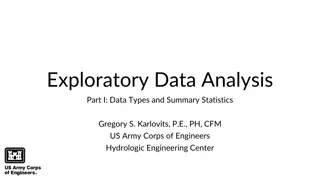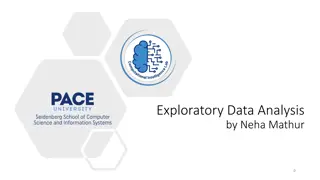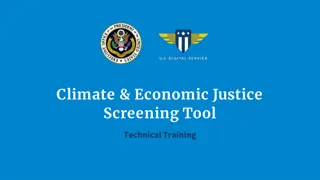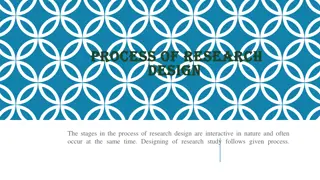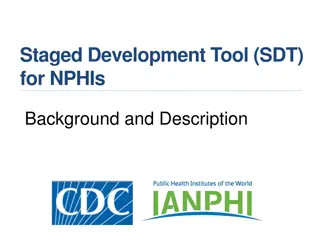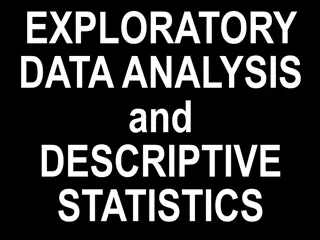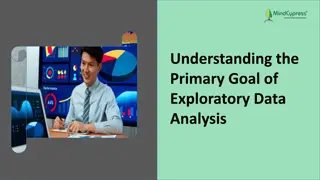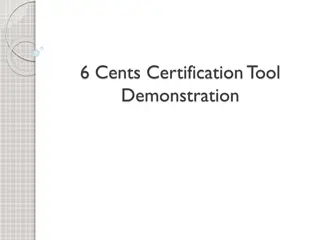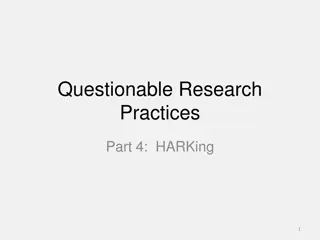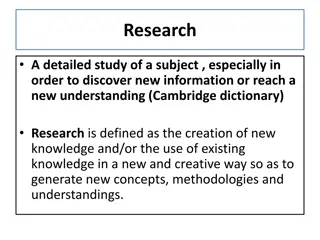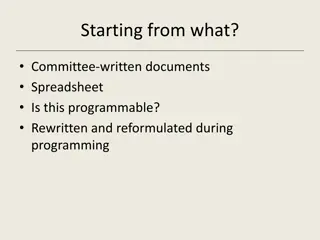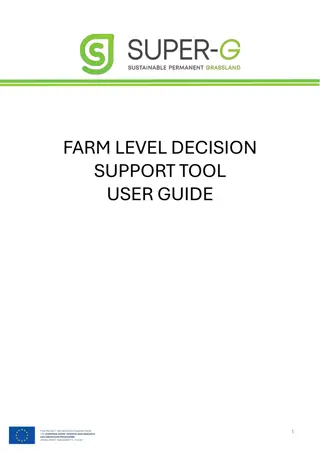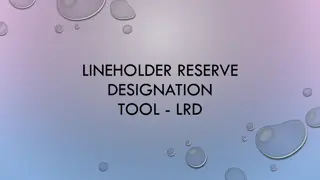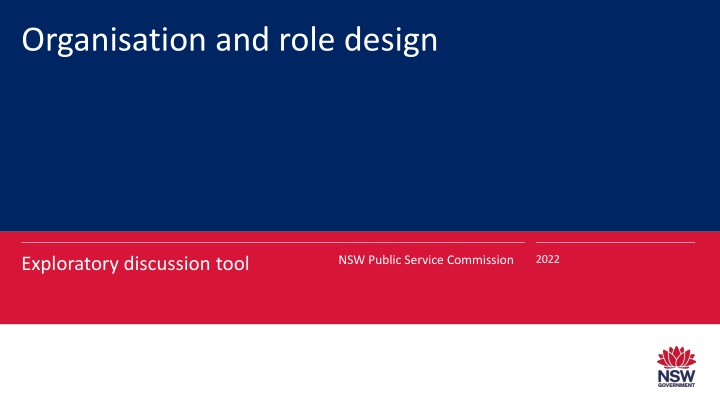
NSW Public Service Commission Organisation and Role Design Tool for Restructuring
Explore the Organisation and Role Design tool provided by the NSW Public Service Commission to support discussions on restructuring within the public sector. This comprehensive tool includes process maps, business partnering guidance, and root cause analysis to guide decision-making. Collaboratively designed with HR professionals, it helps in identifying if a restructure is necessary, setting objectives, designing new structures, and implementing changes effectively. Contact the NSW Public Service Commission for further information or assistance.
Download Presentation

Please find below an Image/Link to download the presentation.
The content on the website is provided AS IS for your information and personal use only. It may not be sold, licensed, or shared on other websites without obtaining consent from the author. If you encounter any issues during the download, it is possible that the publisher has removed the file from their server.
You are allowed to download the files provided on this website for personal or commercial use, subject to the condition that they are used lawfully. All files are the property of their respective owners.
The content on the website is provided AS IS for your information and personal use only. It may not be sold, licensed, or shared on other websites without obtaining consent from the author.
E N D
Presentation Transcript
Organisation and role design 2022 NSW Public Service Commission Exploratory discussion tool
About this tool How to use this tool We encourage you use this tool and have this tool on hand to refer to during the exploratory discussion. An exploratory discussion is the initial discussion you have with your senior leader(s) when they are contemplating a restructure and would like to explore the range of options available. This tool will help guide you to support your senior leader(s) with making a decision about whether a restructure is the right solution. This tool contains a process map, business partnering guidance, questions to support you with the exploratory discussion and a root cause analysis tool. This tool can be used with key decision makers across your organisation in one on one or group discussions . About the development of this tool This tool has been codesigned by and for HR professionals to support them effectively partnering with senior leaders who are contemplating a restructure. It complements (is a complementary resource to) the NSW Public Service Commission s Approach to Organisation and Role Design. It was co-designed in collaboration with experts across NSW Government and refined based on the feedback received from the sector. For further information For further information on what is organisation and role design and when to use it refer to the Approach to Organisation and Role design approach. If you have any questions or feedback, or would like more information on this tool, please contact the NSW Public Service Commission on enquiries- psc@psc.nsw.gov.au Enabling a world class public service Public Service Commission 2
Approach to organisation and role design Explore Goal: Explore organisational needs to identify if a restructure is the right solution Identify Goal: Identify the objectives, scope and desired outcomes for the restructure Design Goal: Develop the organisational design and implementation plan Develop detailed organisational design Is restructuring the right solution? Refer to the exploratory discussion tool Identify scope in collaboration with key stakeholders: Develop the implementation plan Develop detailed project plan and identify: Activities, roles and responsibilities Key milestones Governance Change management and communication plan Risks and mitigation strategies Step 1: Explore strategic objectives, context and desired outcomes for the restructure. Yes Explore organisational context and needs through an exploratory discussion with key decision makers. No Consider alternatives such as: Organisational efficiency Performance management Capability uplift Culture change Minor adjustment to org structure Minor role adjustments including role creation and realignment Step 2: Identify priorities using the Building Blocks for Organisation and Role Design and determine the approach to restructure Develop new structure Develop the new structure which considers and outlines any changes to: Organisation design Roles Processes Systems Ways of working A decision to restructure would include changes to structure, systems, processes, delegations, ways of working, and role design. Step 3: Set the direction for your design decisions and consider any implications. *Note: The Identify stage can be done through workshops, interviews, focus groups or meetings with key stakeholder(s) in your organisation Implement Goal: Implement the new structure using the outputs from the Explore, Identify and Design stages Evaluate Goal: Monitor and evaluate the success of the restructure Enabling a world class public service Public Service Commission 3
Why have an exploratory discussion? The exploratory discussion will: Support you with having an initial discussion with your senior leader(s) Your initial discussion with a senior leader or leaders who are contemplating a restructure can be challenging. Help you understand what your senior leader(s) are trying to do and what outcomes they would like to achieve As an HR representative, you want to be able to support your senior leaders to make good decisions. Help you understand the broader context for the change Senior Leaders may not be aware of their range of options other than a restructure or may not have thought through their objectives or the implications of the change. Help you understand your senior leader(s) approach to change and the business strategy and objectives: some feel daunted but others may rush in Guide your senior leader(s) to consider other options besides restructures (e.g. organisational efficiency, performance management, capability uplift, culture change) You can include one or several key decision makers in the exploratory discussion. Help you and your senior leader(s) reflect on past restructures to identify learnings and position you for a more considered approach to organisation and role design 4 Public Service Commission Enabling a world class public service
Exploratory discussion process 1. Preparation Prepare for the exploratory discussion by identifying and inviting the key decision makers that need to be involved. Think about your organisation s strategic priorities, the needs and priorities of your customers and the key decision makers in your organisation. Review this exploratory discussion tool and choose specific questions to ask, to guide your discussion. And lastly, reflect on how you can use motivational interviewing techniques to support key decision makers with identifying if restructuring is the right solution. 2. Exploratory discussion During the exploratory discussion make sure you listen and reflect on the key points raised in the discussion, and be alert to signs of flexible thinking. Encourage your client to explore alternative options and make sure you cover topics including your organisation s objective, current gaps and issues (and the root causes of any of the issues), risks and opportunities, and your client s hopes, fears and ambitions. 3. Decision point Review the outcomes and insights from the exploratory discussion, to understand if restructuring will resolve the current gaps or issues in the organisation. Decide if restructuring is the right solution after reflecting on the insights from the exploratory discussion. If a restructure: Is required: make sure you explore changes to the organisational structure, role descriptions and design, systems and processes, delegations, and ways of working. Is not required: consider minor adjustments to the organisational structure, performance management, capability uplift, workplace culture change, or minor role adjustments including role creation and realignment. If you a considering a restructure, think about the following questions: What will the restructure look like (small and simple or large and complex)? How long will this restructure take? What do we anticipate the change impact to be (low, medium, high)? What opportunities does a restructure present? What do we know and what do we need to explore? Refer to the Building Blocks in the Approach to Organisation and Role Design resource Who needs to be involved in developing the high level and detailed organisational design? How will we develop the organisational design, change and implementation plan (workshops, interviews, focus groups etc)? Enabling a world class public service Public Service Commission 5
Business partnering guidance What? Collaborate with your senior leaders to strengthen their commitment to a goal by exploring their reasons for change. It involves a combination of following and directing the conversation. Why? Use this partnering approach to support your senior leader in examining their situation and options. This will help expand or challenge their thinking to identify whether restructuring is the right solution. When? Try this approach when your senior leader is contemplating their options, has mixed feelings about change, doubts their ability to achieve change or the benefits of change are unclear. How? 1. Engage your client(s) to build a productive working relationship. Ask them open ended questions, listen and reflect on their situation while affirming that they have a range of alternative options. Identify and focus on a shared purpose before guiding your senior leader towards positive options for change. Develop a rationale by exploring ideas and motivations. Be responsive to the senior leader s thoughts and intentions regarding alternative courses of action and reflect on the likely consequences of each. Plan follow-up actions to consolidate their commitment to positive options for change. 2. 3. 4. Need some business partnering inspiration? Go to the NSW Public Service Commission s The Spark: Shaping a World Class HR and listen to the below podcasts: Episode 10: Changing role of HR: partnering with the business to identify, develop and execute workforce strategies Episode 11: Changing role of HR: the reality of what business partnering is and how it can be achieved through business acumen, 'soft skills' and problem solving Public Service Commission Enabling a world class public service 6
Exploratory discussion questions Rationale for change What is driving the change? What s working? What s not? If there are issues, what are the root causes? Business strategy What business outcomes do you need to achieve, now and in the future? If you knew the answer, what would it be? How does the change relate to organisational strategies and plans? Values What values are important to you? How will the change reflect those values? Plans for change What are your hopes, fears and ambitions? What do you plan to change? What will stay the same? Have you made changes before? How did it go? Feasibility What alternatives have you considered? Who else is driving the change? What budget and resources do you have? Public Service Commission Enabling a world class public service 7
Exploratory discussion questions (cont.) Risks What risks and impacts do you anticipate? How will you mitigate them? How might this impact you? Support Whose support do you need to make the change and do you have it? What will it mean for you, your team, the organisation and customers? What systems and processes do you need to change to support the change? Measuring outcomes How will you measure success? How long will it take to see results? Next steps Yes, our organisation will commence a restructure: If the decision makers in your organisation decide to proceed with a restructure, begin to identify how HR can support to achieve the change. Refer to the Approach to Organisation and Role Design, Situation Worksheet, Approach Worksheet, Design Flowchart and Roadmap Template for more information and guidance. No, our organisation will not commence a restructure: Consider identifying and implementing ways to improve your organisation s performance, capability development, people management, performance management, role design and clarity, workplace culture, values and behaviours, current systems, processes and ways of working. Public Service Commission Enabling a world class public service 8
Root cause analysis tool Defining the issue Identify contextual factors Identify the root cause Implement solutions Collect data What is the impact of the issue? How long has it been going on? What do you see happening? Which events have led up to the issue? What is the context? What is the real reason for the issue? Consider capability, people management, role design, culture, networks, systems, processes etc Break down the issue into small parts to understand the bigger picture Develop a mind map of possible causal factors to trace back to the root cause What will you do to achieve the future you want? Is a restructure really required? Public Service Commission Enabling a world class public service 9


